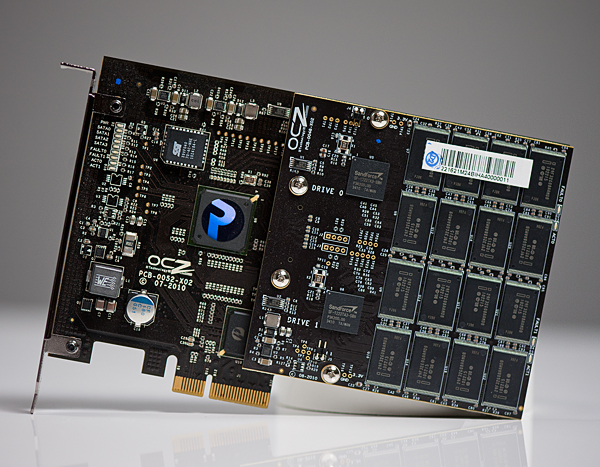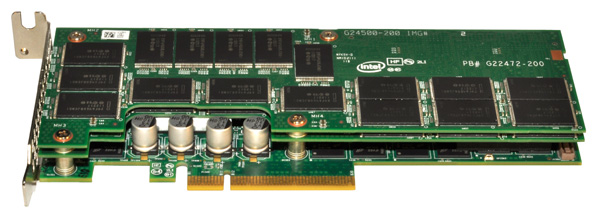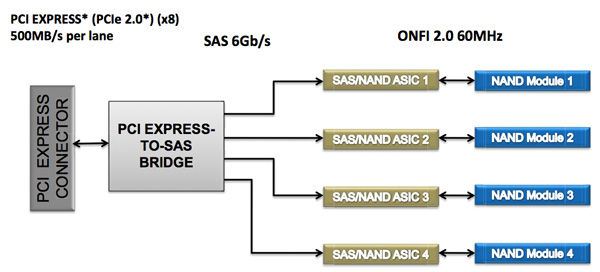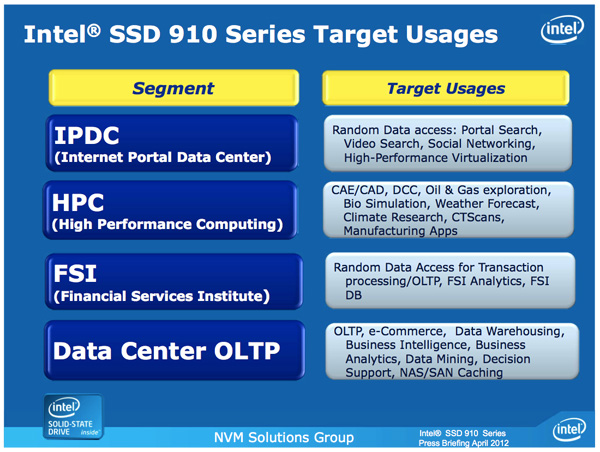Intel's SSD 910: Finally a PCIe SSD from Intel
by Anand Lal Shimpi on April 12, 2012 3:00 AM EST- Posted in
- Storage
- SSDs
- Intel
- Intel SSD 910
Solid state storage has quickly been able to saturate the SATA interface just as quickly as new standards are introduced. The first generation of well-built MLC SSDs quickly bumped into the limits of 3Gbps SATA, as did the first generation of 6Gbps MLC SSDs. With hard drives no where near running out of headroom on a 6Gbps interface, it's clear that SSDs need to transition to an interface that can offer significantly higher bandwidth.
The obvious choice is PCI Express. A single PCIe 2.0 lane is good for 500MB/s of data upstream and downstream, for an aggregate of 1GB/s. Build a PCIe 2.0 x16 SSD and you're talking 8GB/s in either direction. The first PCIe 3.0 chipsets have already started shipping and they'll offer even higher bandwidth per lane (~1GB/s per lane, per direction).
PCI Express is easily scalable and it's just as ubiquitous as SATA in modern systems, it's a natural fit for ultra high performance SSDs. While SATA Express will hopefully merge the two in a manner that preserves backwards compatibility for existing SATA drives, the server market needs solutions today.
In the past you needed a huge chassis to deploy an 8-core server, but thanks to Moore's Law you can cram a dozen high-performance x86 cores into a single 1U or 2U chassis. These high density servers are great for compute performance, but they do significantly limit per-server storage capacity. With the largest eMLC drives topping out at 400GB and SLC drives well below that, if you have high performance needs in a small rackmount chassis you need to look beyond traditional 2.5" drives.
Furthermore, if all you're going to do is combine a bunch of SAS/SATA drives behind a PCIe RAID controller it makes more sense to cut out the middleman and combine the two.

Micron's P320h
We've seen PCIe SSDs that do just that, including several from OCZ under the Z-Drive and RevoDrive brands. Although OCZ has delivered many iterations of PCIe SSDs at this point they all still follow the same basic principle: combine independent SAS/SATA SSD controllers on a PCIe card with a SAS/SATA RAID controller of some sort. Eventually we'll see designs that truly cut out the middlemen and use native PCIe-to-NAND SSD controllers and a simple PCIe switch or lane aggregator. Micron has announced one such drive with the P320h. The NVMe specification is designed to support the creation of exactly this type of drive, however we have yet to see any implementations of the spec.
Many companies have followed in OCZ's footsteps and built similar drives, but many share one thing in common: the use of SandForce controllers. If you're working with encrypted or otherwise incompressible data, SandForce isn't your best bet. There are also concerns about validation, compatibility and reliability of SF's controllers.
Intel's SSD 910
Similar to its move into the MLC SSD space, Intel is arriving late to the PCIe SSD game - but it hopes to gain marketshare on the back of good performance, competitive pricing and reliability.
The first member of the new PCIe family is the Intel SSD 910, consistent with Intel's 3-digit model number scheme.
| Enterprise SSD Comparison | ||||||
| Intel SSD 910 | Intel SSD 710 | Intel X25-E | Intel SSD 320 | |||
| Interface | PCIe 2.0 x8 | SATA 3Gbps | SATA 3Gbps | SATA 3Gbps | ||
| Capacities | 400 / 800 GB | 100 / 200 / 300GB | 32 / 64GB | 80 / 120 / 160 / 300 / 600GB | ||
| NAND | 25nm MLC-HET | 25nm MLC-HET | 50nm SLC | 25nm MLC | ||
| Max Sequential Performance (Reads/Writes) | 2000 / 1000 MBps | 270 / 210 MBps | 250 / 170 MBps | 270 / 220 MBps | ||
| Max Random Performance (Reads/Writes) | 180K / 75K IOPS | 38.5K / 2.7K IOPS | 35K / 3.3K IOPS | 39.5K / 600 IOPS | ||
| Endurance (Max Data Written) | 7 - 14 PB | 500TB - 1.5PB | 1 - 2PB | 5 - 60TB | ||
| Encryption | - | AES-128 | - | AES-128 | ||
The 910 is a single-slot, half-height, half-length PCIe 2.0 x8 card with either 896GB or 1792GB of Intel's 25nm MLC-HET NAND. Part of the high endurance formula is extra NAND for redundancy as well as larger than normal spare area on the drive itself. Once those two things are accounted for, what remains is either 400GB or 800GB of available storage.
The 910's architecture is surprisingly simple. The solution is a layered design composed of two or three boards stacked on one another. The first PCB features either two or four SAS SSD controllers, jointly developed by Intel and Hitachi (the same controllers are used in Hitachi's Ultrastar SSD400M). These controllers are very similar to Intel's X25-M/G2/310/320 controller family but with a couple of changes. The client controller features a single CPU core, while the Intel/Hitachi controller features two cores (one managing the NAND side of the drive while the other managing the SAS interface). Both are 10-channel designs, although the 910's implementation features 14 NAND packages per controller.
In front of the four controllers is an LSI 2008 SAS to PCIe bridge. There's no support for hardware RAID, each controller presents itself to the OS as a single drive with a 200GiB (186GB) capacity. You are free to use software RAID to aggregate the drives as you see fit but by default you'll see either two or four physical drives appear.
The second PCB is home to 896GB of Intel's 25nm MLC-HET NAND, spread across 28 TSSOP packages. The third PCB is only present if you order the 800GB version, and it adds an extra 896GB of NAND (another 28 packages). Even in a fully populated three-board stack, the 910 only occupies a single PCIe slot.
The 910's TDP is set at 25W and requires cooling capable of moving air at 200 linear feet per minute for proper operation.
The use of LSI's 2008 SAS PCIe controller makes sense as there's widespread OS support for the controller, in many cases you won't need to even supply a 3rd party driver. The 910 isn't bootable, but I don't believe that's much of an issue as you're more likely to deploy a server with a small boot drive anyway. There's also no support for hardware encryption, a more unfortunate omission.
Intel's performance specs for the 910 are understandably awesome:
| Intel SSD 910 Performance Specs | ||||
| 400GB | 800GB | |||
| Random 4KB Read (Up to) | 90K IOPS | 180K IOPS | ||
| Random 4KB Write (Up to) | 38K IOPS | 75K IOPS | ||
| Sequential Read (Up to) | 1000 MB/s | 2000 MB/s | ||
| Sequential Write (Up to) | 750 MB/s | 1000 MB/s | ||
Intel's specs come from aggregating performance across all controllers, but you're still looking at a great combination of performance and capacity. These numbers are applicable to both compressible and incompressible data.
The 910 will ship with a software tool that allows you to get even more performance out of the drive (up to 1.5GB/s write speed) by increasing the board's operating power to 28W from 25W.
| Intel SSD 910 Endurance Ratings | ||||
| 400GB | 800GB | |||
| 4KB Random Write | Up to 5PB | Up to 7PB | ||
| 8KB Random Write | Up to 10PB | Up to 14PB | ||
The 910 is rated for up to 2.5PB of 4KB or 3.5PB of 8KB random writes per NAND module (200GB).
The pricing is also fairly reasonable. The 400GB model carries a $1929 MSRP while the 800GB will set you back $3859, both come in below $5/GB. Samples are available today, with the first production of Intel's SSD 910 available sometime in the first half of the year.
| Intel SSD 910 Pricing | ||||
| 400GB | 800GB | |||
| MSRP | $1929 | $3859 | ||
| $ per GB | $4.8225 | $4.8238 | ||
I have to say that I'm pretty excited to see Intel's 910 in action. Intel's reputation as an SSD maker carries a lot of weight in the enterprise market already. The addition of a high-end PCIe solution will likely be well received by its existing customers and others who have been hoping for such a solution.















71 Comments
View All Comments
WeaselITB - Thursday, April 12, 2012 - link
<protest> But Linksys and Cisco are the same company! </protest>/sarcasm
I kid, I kid ... just couldn't resist. :-)
-Weasel
dlitem - Thursday, April 12, 2012 - link
Just like you'd never pay for more than ~2c per a gallon of Coke, since even that is probably more than the manufacturing price of the stuff?Value and price are different things. If this thing can replace a full rack of spinning disks powering some high-activity database, it could be considered cheap as dirt. Regardless of the manufacturing cost.
neotiger - Thursday, April 12, 2012 - link
For a PCIe card I'd expect much more than 90K IOPS.A comparable PCIe card Z-Drive R4 is much better at 250K- 400K IOPS
As it stands right now, 90K IOPS is no better than a Vertex 4.
Makaveli - Thursday, April 12, 2012 - link
So would you rather put a couple Vertex 4 in your server then.......euler007 - Thursday, April 12, 2012 - link
Maybe he doesn't like his job. It would be more subtle then spilling your coffee inside the server.neotiger - Saturday, April 14, 2012 - link
No. But I'd rather put in a Z-Drive R4.Maybe you should learn to read the entire post
ats - Saturday, April 14, 2012 - link
The Z-Drive has lower performance in the same test conditions.Casper42 - Friday, April 13, 2012 - link
1.28 TB Fusion IO does 150K IOPS and costs $25K retail.So 800GB and 90K at 1/5th the price isn't actually so bad.
Enterprise drives also usually measure IOPS in a mixed workload environment. Not sure how that affects the numbers but your Vertex 4 number is most likely Read or Write but not mixed.
ats - Saturday, April 14, 2012 - link
No, a comparable Z-Drive R4 is at 48K write IOPS. Don't confuse best case write IOPS with FULL SPAN STEADY STATE RANDOM WRITE IOPS.theeldest - Thursday, April 12, 2012 - link
I'd like to know if those IOPS numbers are sustained over time or peak.If you look at OCZs drives (or anything with a sandforce controller) your IOPS pretty quickly fall far below what the drive is rated for because garbage collection can't keep up.
If the drive doesn't drop as much during sustained operation than it's a much better deal.
Anand, when you finally get to test this drive can you do a sustained test? It's unrealistic for consumers but in the enterprise space there are more people that would actually benefit from seeing that comparison.
(by sustained, I mean high random/sequential read & writes for at least double the time it takes to write to all blocks).
I remember a benchmark where the Vertex2 EX dropped from 50k IOPS to 15k IOPS after 12 minutes.
Consumer benchmarks != Enterprise benchmarks